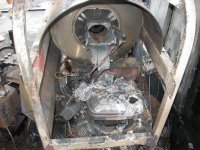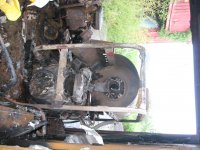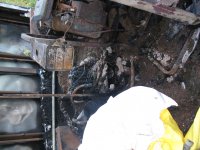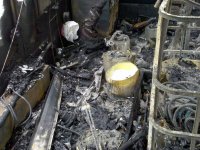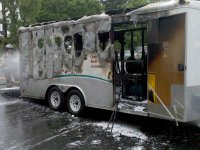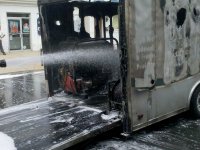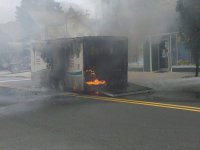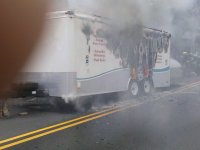Perhaps this is a good time to remember the dangers of gas cans:
Filling a portable gasoline can at a service station is something most of us do dozens of times each summer, whenever the lawn mower, chain saw or ATV runs low on gas. In fact, it happens so frequently that we don't even think about it. According to safety experts at Chevron Corporation, however, we should think about it. They warn there is a potential risk of fire due to static electricity buildup when filling a portable container -- especially if the fuel can is left in the trunk of a car or the back of a pickup.
Despite the potential for tragedy, gasoline fires caused by static electricity are rare. Only 24 fires and 5 injuries during the past few years have been reported due to improper fueling of portable cans. When you consider that millions of gasoline cans are filled at pumps every year, these figures don't make it seem like much of a problem -- unless it happens to you.
Gasoline, by its very nature, is extremely volatile. We’ve all seen the explosive fumes rising from the fuel filler on a hot day, and there is always a danger of a fire when fueling any vehicle or filling a container. That is why filling stations have signs out by the pumps that tell you not to smoke and to turn off the engine. Still, as dangerous as fill-ups can be, fires caused by static electrical build up while filling a vehicle are so rare because both the vehicles and the pumps are designed to dissipate the static electricity to the ground. Your vehicle may not appear to be grounded, but Chevron's safety engineers say the tires are good enough conductors to allow electrical discharge to escape to ground under normal conditions.
An approved gasoline container also dissipates static electricity, as long as it is placed on the pavement before filling begins. Leave the can in the trunk or pickup box, however, and it is a different story. A trunk liner, bed mat or bed liner insulates the vehicle from the ground and the static buildup of electricity has nowhere to go. Static buildup occurs and if it releases, the resulting spark can set off the gasoline.
The static comes from the gasoline itself. As the fuel flows through the hose and nozzle, static electricity builds up on the gasoline. This charge takes several seconds to dissipate after the gas is poured into the can. If the can is insulated from ground, the spark cannot dissipate and it builds up until discharge occurs.
According to Chevron, the condition most likely to lead to spark discharge is the filling of a metal container that is placed upon the plastic bedliner of a pickup. In their experiments, this situation resulted in the most fires. They are also quick to point out that while static discharge in metal containers caused the most fires, plastic containers are not immune.
To avoid static electricity fires -- and the other dangers inherent in handling highly flammable fuel -- Chevron suggests the following:
* Use only approved and properly labeled gasoline containers. The gas can should be red in color and have a Underwriter's Laboratories (UL) or the American Society for Testing and Materials (ASTM) stamp on them.
* Place the container on the ground before filling to allow static buildup to dissipate. Make sure the filler nozzle touches the rim of the filler opening to help static electricity dissipate.
* Fill the container only 95 percent full. Leave an air space so the fuel can expand as temperatures increase.
* Always fill the can manually; never use the trigger lock on the nozzle.
* Turn off your car's motor before fueling and extinguish any cigarettes or open flames.
* Never fill a container inside a vehicle or truck bed.
* Wipe the can clean before putting it in the vehicle (or hose it off).
* Secure the can in the vehicle so it won't slide around.
* Never leave a can in your vehicle for extended periods.
* Don’t breathe gasoline fumes. They are extremely harmful to your health.


